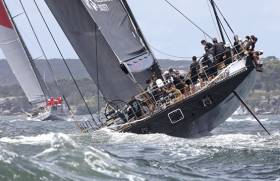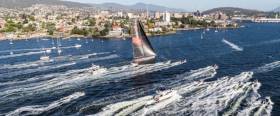Displaying items by tag: Sydney Hobart Yacht Race
170 Boats Set To Line Up For 2019 Rolex Sydney Hobart
Entry for the Rolex Sydney Hobart Yacht Race has now closed — and organisers at the Cruising Yacht Club of Australia (CYCA) have announced that 170 yachts from Australia and overseas will take part in their 75th race.
This will make it the largest fleet since the 50th in 1994 in which a record 371 yachts started, and the fourth-largest in the history of the race.
Commenting on the fleet, CYCA Commodore Paul Billingham said: “To receive such an incredible number of entries this year is astonishing and testimony to the enduring appeal of the Great Race.
“The range of yachts is truly impressive and the spectacle we will witness on Boxing Day will be unprecedented in the modern era of the race.”
Among this year’s number are five super-maxis: Peter Harburg’s Black Jack (Qld); Jim Cooney and Samantha Grant’s record-holder Comanche (NSW); Christian Beck’s InfoTrack (NSW); the Oatley family’s reigning line-honours champion, Wild Oats XI (NSW); and Seng Huang Lee’s SHK Scallywag from Hong Kong.
International boats are representative of Ireland, Great Britain, France, China, Hungary, Poland, Hong Kong and USA — and while New South Wales has predictably yielded the largest Australian numbers, with 96, the other states have produced healthy numbers, too.
There are also a few ‘first timers’, most notably the first Aboriginal crew to ever take part in the race with the Beneteau 47.7, Tribal Warrior.
There are 10 past overall winners representative of various sizes and eras, from the 2018 winner, Philip Turner’s RP66 Alive; Matt Allen’s TP52 Ichi Ban; Bob Steel’s TP52 Quest, which also won as Paul Clitheroe’s Balance seven years later; Oskana, a Cookson 50 that won as Victoire in 2013; Simon Kurts’ 46-year-old classic yacht, Love & War, one of only two three-time winners in the race’s history; and two-time winner Wild Oats XI.
Fleet Already Building For 75th Sydney Hobart Yacht Race
A mix of newcomers and race-winning veterans headline a 75-strong list already entered in the 75th editor of the Rolex Sydney Hobart Yacht Race which sets sail less than seven months from now, on Thursday 26 December.
The Cayman Islands-registered Caro is the latest, returning to the race after a five-year hiatus, bringing the number of entries to 75 with five months remaining for further entries.
Two multiple-race-winning yachts, Love & War and Quest, have officially announced their return, with many more expected before entries close on 25 October — hopefully including, for Irish interests, last year’s line-honours winners Wild Oats XI.
Oskana (previously Victoire) is another previous winner who’s registered for the 2019 Rolex Sydney Hobart, having won the Tattersall Cup in 2013.
Simon Kurts’ Sparkman & Stephens 47, Love & War (NSW), is one of only two yachts to ever win the Tattersall Cup three times — in 1974, 1978 and 2006 — and is making her triumphant return after a few years’ absence from the great race.
Alongside her entry is Bob Steel’s TP52, Quest, a two-time overall winner in 2008 as Quest and 2015 as Balance.
The 2019 Rolex Sydney Hobart could also feature a strong fleet of rookies. New to offshore racing is Mark Spring, who has entered Highly Sprung.
Spring bought the Beneteau 45 in Thailand before racing her in 2018 Hamilton Island Race Week. She won the Pittwater to Paradise earlier this year — and now Spring has his sights set on Boxing Day.
“We’ve been putting in the time and effort on the water and done some team performance evenings and lots of races to get ready for the Hobart,” Spring says.
“I’ve chosen some mates that sail a bit, and then some others who have sailed a lot. We’ve got a well-rounded team and some that are serious offshore racers.”
The bulk of the 2019 Rolex Sydney Hobart Yacht Race fleet currently sits in the 40-50ft range, where most yacht owners have their eye on the Tattersall Cup for the overall win.
French entrant Daguet (Mylius 50), About Time (Cookson 50) and Carrera S (Marten 49) are just some of the first-timers who join the likes of race veterans Black Sheep (Beneteau First 45), Chancellor (Beneteau 47.7) and Last Tango (Salona 44) in the hotly contested range.
The returning yachts with their sights on line-honours victory include Peter Harburg’s Black Jack (Qld) and Christian Beck’s Infotrack (NSW), the 2016 Rolex Sydney Hobart line-honours winner as Perpetual Loyal.
The race within the race for line honours is sure to grow as more 100ft supermaxis are expected to enter the 75th Rolex Sydney Hobart, which starts on spectacular Sydney Harbour on 26 December before heading south, finishing at Constitution Dock in Hobart, Tasmania.
The 75th anniversary of the race will include a number of exciting features for both competitors and fans, with further information to be released in the months ahead.
Prospective entrants can find out how to take part in the 2019 Rolex Sydney Hobart Yacht Race HERE.





























































